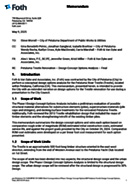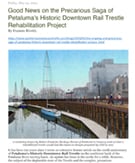1/9/25 | On Thursday, January 9, at the Petaluma Historical Library & Museum. organizations dedicated to protecting and enhancing access to the Petaluma River came together for a special event inspired by the book The Petaluma River: A Sketch Journal and Brief Historical Overview by Alan Butler and Katherine J. Rinehart. Special guest speakers included: • Stephanie Bastianon, Executive Director, Friends of the Petaluma River • Seair Lorentz, Executive Director, Petaluma River Park Foundation • Greg Sabourin, Executive Director, The Floathouse • Steve Worrell, City of Petaluma Project Manager,
Historic Trestle Rehabilitation
(reading Gina Benedetti-Petnic’s statement) “The Petaluma historic trestle constructed in 1922 stands as a testament to Petaluma's rich heritage as a bustling hub of commerce and transportation. Strategically positioned along the southwest bank of the turn basin in downtown Petaluma. This 500 ft timber railroad trestle was integral in linking the Petaluma River to the regional rail system. This connection facilitated the efficient movement of goods between the San Francisco Bay area and the city of Petaluma. Over the years, the trestle has not only been a conduit for commerce, but also a cherished community gathering spot, offering residents and visitors alike a unique vantage point to appreciate the river's Beauty and the city's vibrant activities. However, time has taken its toll, and the structure has deteriorated, leading to its closure to public access, recognizing its historical and cultural significance, the city of Petaluma has embarked on an ambitious project to rehabilitate the trestle. The vision is to transform it into a thriving public space that honors its storied past while serving the community's future needs. As we reflect on the trestle's legacy within the context of the Petaluma River's history, we celebrate its role in shaping the City's identity. The ongoing efforts to restore and repurpose this historic structure underscore a commitment to preserving Petaluma's heritage, ensuring that the trestle remains a symbol of the city's enduring connection to its riverfront roots."
• Rosemary Hart, Civic Engagement Chair,
Petaluma Woman's Club
"We ask the city, 'Why are we not working on this often?' a lot of the answers are 'SMART owns it.' But it's been four years now and still don't have an MOU (memorandum of understanding) or negotiation with SMART to figure out that answer. An MOU is really important for grant money.
So without the project going forward since 2021 the PWC has tried to raise awareness and encourage the city to move forward on this important project. We've met regularly with the City Council and city staff. We're actually on our second Mayor and third City Council trying to encourage them to move ahead on this high priority and important project."
• Joan Cooper, Friends of Shollenberger Park • David Keller, Project Manager, Petaluma River Council
| Complete YouTube video:
 
Transcript of Gina Benedetti-Petnic’s statement:  

|
5/9/25 | Petaluma Trestle Renovation – Design Concept Options Analysis – Final
Prepared by Foth Engineering and Design for Petaluma Public Works Dept
This document describes the 8 design options that Foth came up with in addition to the 2013 option. These take into consideration the “Wood Condition Assessment” by Porter & Assoc. submitted 7/14/23 (see above).
- Only the 2013 option calls for re-use and repair of existing Trestle materials
- 5.2 Railroad Heritage and Historical Significance on
 Pg 24 explains the value of re-use & repair (as in 2013 option) to maintain historic significance Pg 24 explains the value of re-use & repair (as in 2013 option) to maintain historic significance
- Table 7-4 Summary of ROM Cost Estimates on
 Pg 44 shows that the 2013 option is the lowest cost per linear foot compared to the other 8 options Pg 44 shows that the 2013 option is the lowest cost per linear foot compared to the other 8 options
- The last paragraph on
 Pg 41 - 42 points out “Design Options 1 through 8 would involve the demolition of the existing Petaluma Trestle” and that “project would have a “significant and unavoidable” impact to the historic resource, the Petaluma Trestle, under CEQA and an “adverse effect” on the historic resource under Section 106 of the NHPA.” Pg 41 - 42 points out “Design Options 1 through 8 would involve the demolition of the existing Petaluma Trestle” and that “project would have a “significant and unavoidable” impact to the historic resource, the Petaluma Trestle, under CEQA and an “adverse effect” on the historic resource under Section 106 of the NHPA.”
- “A finding that the project would have an “adverse effect” on the historic resource under Section 106, would result in the lead federal agency negotiating and executing a Memorandum of Agreement (MOA) with the State Historic Preservation Officer (SHPO). This MOA will outline measures to minimize, avoid, or mitigate the adverse effects.” The “SHPO will seek input from local historic preservation groups for mitigation suggestions. Incorporating a design that honors the Trestle’s original design may also serve as a mitigation measure.”
- This might force the designers and engineers to return to some version of the 2013 option.
- Even though the 2013 option does a better job of maintaining historic significance on
 Pg 24 and the other options all require demolition of the Trestle which will run into opposition from Section 106 ( Pg 24 and the other options all require demolition of the Trestle which will run into opposition from Section 106 ( see Pg 42) and the methods used by the 2013 option are the least expensive ( see Pg 42) and the methods used by the 2013 option are the least expensive ( see Pg 44) this document goes out of its way to deprecate the 2013 option see Pg 44) this document goes out of its way to deprecate the 2013 option
- Table 7-5
 Pg 44 ranks 2013 option lowest in terms of service life. This is based on Table 2-2 Pg 44 ranks 2013 option lowest in terms of service life. This is based on Table 2-2  Pg 15 where Preservative Treated (Softwoods) rate a 30 Year Service Life and Protective Pile Jacketing or Encasement rates a 25 Year Service Life, much lower than new Greenwood pilings, concrete or steel Pg 15 where Preservative Treated (Softwoods) rate a 30 Year Service Life and Protective Pile Jacketing or Encasement rates a 25 Year Service Life, much lower than new Greenwood pilings, concrete or steel
However, the service life numbers are questionable. These are our considerations: - Rating Softwoods at 30 years seems very conservative based on the example of the existing Trestle. The pilings are all softwood (either untreated redwood or treated Douglas fir) and they supported the Trestle and 200 ton locomotives successfully for 70 years until abandoned in the 1990s, despite minimal maintenance & intertidal deterioration.
- Rating jacketing or casing methods at 25 years is highly misleading as it is based on the manufacturer’s warrantee period and the manufacturer expects the product to last much longer. Other PVC based docking materials for saline environments are expected to last 50 plus years. (this info was provided by both the distributor and the manufacturer and patent-holder of Snap-Jacket, a PVC jacket that can be applied without removing the superstructure and when filled with concrete grout becomes extremely durable. The product was created expressly to extend the life of marine docks without having to demolish superstructure).
- Jacketing the existing softwood piles would greatly increase their service life
- Jacketing existing treated softwood piles would also answer environmental concerns by preventing the leaching of creosote into river
- The Pile Bent Caps, Stringers, joists and ties (all treated softwoods) are always above high tide line. Most of the major components, the bent caps and stringers, are in good to excellent condition and do not leach Creosote because they are never submerged in the river.
| Click thumbnail image to see entire document 
Links in text go to individual pages of this document |
| 5/19/25 | Steve Worrell, Public Works to Mayor & City Council - “Recommendation to Receive an Update on the Trestle Rehabilitation Project”
On  Pg 3 of the report they reach the conclusion that: Pg 3 of the report they reach the conclusion that: “The 2013 rehabilitation design, which proposed partial reuse and retrofit of existing timber members, was re-evaluated. However, the design was found to be constrained by a shorter anticipated service life (20–30 years) and continued environmental permitting challenges due to the retention of creosote-treated materials. For these reasons, the 2013 rehabilitation design is no longer being recommended for advancement.”
Editor's note: As in the Foth report of 5/9/25, the service life of the existing wood combined with PVC jacketing is under-estimated and ignores that the combination would seal in any toxics. Also, removing any treated wood just moves the environmental hazard to a new location.
| Click thumbnail image to see entire document |


















